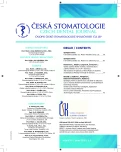-
Medical journals
- Career
The Incidence of Agenesis of Third Molars in Students of Dentistry at Palacký University in Olomouc
Authors: L. Kramerová 1; P. Krejčí 1; K. Langová 2; Ševecová A.klinika Zubního Lékařství Lf Up 1; Fn; Olomouc
Authors‘ workplace: Ústav lékařské biofyziky LF UP, Olomouc 2
Published in: Česká stomatologie / Praktické zubní lékařství, ročník 115, 2015, 3, s. 61-69
Category: Original Article - Case - Control Study
Overview
Aim of the study:
Tooth agenesis is very often developmental disorder, its prevalence is the topic of numerous research works. The results of various authors usually differ from each other depending on the methodology and other factors, but one outcome is always the same - the most often missing teeth are the third molars. The aim of our study was to find out the prevalence of the agenesis of the third molars in students of the dentistry program at Palacký University in Olomouc, to compare how often the anomaly is in men and in women, to determine the absence of the third molars in particular oral quadrants, to find out the most often number of the missing third molars and the most often localization and to draw a comparison between this study and the former one which was aimed on the incidence of the tooth agenesis in boys and girls at the age from 13 to 19 and finally to compare our outcomes to the outcomes of the study conducted by Rozkovcová and others (2004).Methods:
The study was conducted from 1. 2. 2013 to 30. 6. 2014. Students of the second up to the fifth year of the dentistry program at Palacký University in Olomouc were examined clinically and X-rays were taken to diagnose any tooth agenesis. Only healthy individuals were included in the study. The data received in the examination were statistically evaluated.Results:
Our file contained 343 students. The prevalence of the agenesis of one to four third molars was set to 19.26 % in women (47 out of 244 women), 15.15 % in men (15 out of 99 men), for both genders the number was 18.08 % (62 out of 343 individuals). Most of the subjects presented only one missing third molar out of four possible. However statistically significant differences between the absence of one (35 % of individuals), two (26 % individuals), three (16 % of individuals) and four (23 % of individuals) were not detected. The most often missing tooth was the left upper third molar (40 teeth out of 140 total). Nevertheless the differences between the individual locations of the missing teeth were not significant.Conclusion:
Our case study showed the prevalence of the agenesis of the third molars in students of the dentistry program at Palacký University in Olomouc. The outcomes were compared with our original study (see Prakt. zub. Lék., roč. 62, 2014, č. 3, s. 35-42) and with the epidemiological research conducted by Rozkovcová and others (2004). The analysis of the collected data showed significantly lower prevalence than the one determined in the file of teenagers (29.71%) signed to regular check ups in Pediatric dentistry department in Dental clinic in Faculty of medicine in Palacky University. Statistically important in the file of students was also lower incidence of cases of missing only one third molar and of cases with missing left lower third molar. The frequency of the incidence of the tooth agenesis published by Rozkovcová and others (2004) (22.14%) was not statistically important. The agenesis of two of the third molars is described as statistically higher.Keywords:
hypodontia – agenesis of third molars – incidence of agenesis of third molars
Sources
1. Gábrlíková, L.: Ageneze zubů. Prakt. zub. Lék., roč. 60, 2012, č. 5, s. 97–102.
2. Galluccio, G., Castellano, M., La Monaca, C.: Genetic basis of non-syndromic anomalies of human tooth number. Arch. Oral Biol., roč. 57, 2012, č. 7, s. 918–930.
3. Kramerová, L., Krejčí, P., Kaplová, E., Langová, K.: Výskyt ageneze třetích molárů u dětí a mladistvých v Olomouckém kraji. Prakt. zub. Lék., roč. 62, 2014, č. 3, s. 35–42.
4. Kramerová, L., Krejčí, P., Míšová, E., Ševecová, A.: Molekulární a genetické aspekty vzniku nesyndromické ageneze zubů. Čes. Stomat., roč. 115, 2015, č. 1, s. 4–11.
5. Rozkovcová, E., Dostálová, T., Marková, M., Broukal, Z.: The third molar as an age marker in adolescents: New approach to age evaluation. J. For. Sci., roč. 57, 2012, č. 5, s. 1323–1328.
6. Rozkovcová, E., Marková, M., Lánik, J., Zvárová, J.: Agenesis of third molars in young Czech population. Prague Med Rep., roč. 105, 2004, č. 1, s. 35–52.
7. Rozkovcová, E., Marková, M., Lánik, J., Zvárová, J.: Development of third molar in the Czech population. Prague Med Rep., roč. 105, 2004, č. 4, s. 391–422.
8. Rozkovcová, E., Marková, M., Mrklas, L.: Nové přístupy k problematice třetího moláru. Čes. Stomat., roč. 105, 2005, č. 5, s. 119–128.
9. Vastardis, H.: The geneticsof human tooth agenesis: new discoveries for understanding dental anomalies. Amer. J. Orthodont. dentofacial Orthop., roč. 117, 2000, č. 6, s. 650–656.
Labels
Maxillofacial surgery Orthodontics Dental medicine
Article was published inCzech Dental Journal

2015 Issue 3-
All articles in this issue
- The Incidence of Agenesis of Third Molars in Students of Dentistry at Palacký University in Olomouc
-
Dental Caries Prevention Strategies, Application of Evidence-Based Medicine
Part II. Current Treatment, Preventive and Prophylactic Technologies. Fluorides. - New Pharmacotherapeutic Posssibilities in Contemporary Dentistry
- Impacted Canines
- Czech Dental Journal
- Journal archive
- Current issue
- Online only
- About the journal
Most read in this issue- Impacted Canines
-
Dental Caries Prevention Strategies, Application of Evidence-Based Medicine
Part II. Current Treatment, Preventive and Prophylactic Technologies. Fluorides. - New Pharmacotherapeutic Posssibilities in Contemporary Dentistry
- The Incidence of Agenesis of Third Molars in Students of Dentistry at Palacký University in Olomouc
Login#ADS_BOTTOM_SCRIPTS#Forgotten passwordEnter the email address that you registered with. We will send you instructions on how to set a new password.
- Career

